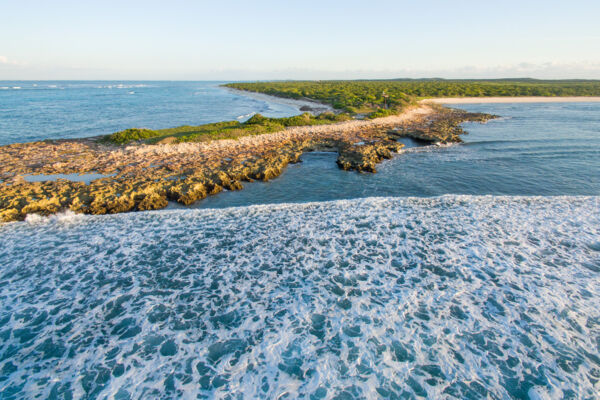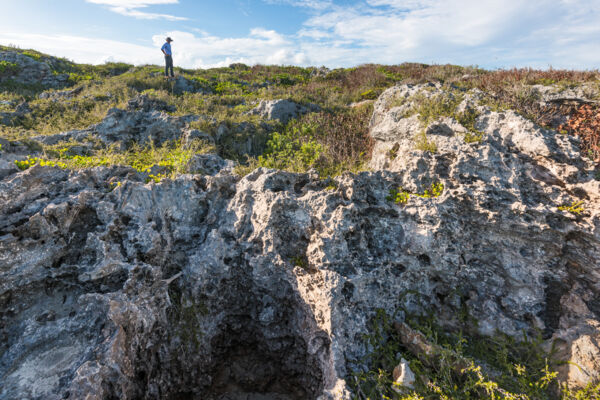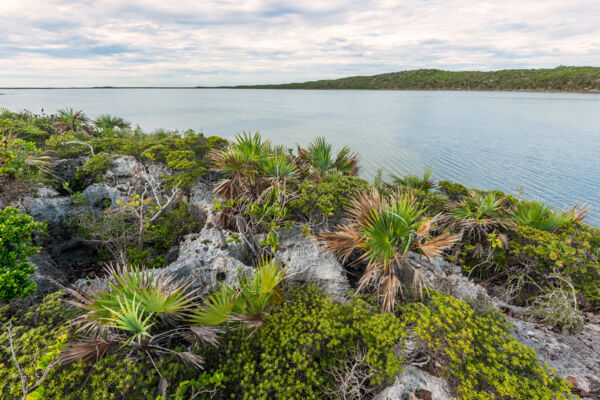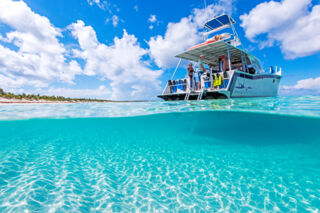Providenciales Hiking

As is the case throughout the Turks and Caicos, and due to the small size of the islands, the environment of Providenciales bears a markedly coastal feel.
Low dry tropical forest, typically quite dense, covers much of the interior landscapes, and extensive marine wetlands, white sand beaches and low limestone cliffs make up the majority of coasts. This unique scenery is only shared with a few of the southern Bahamian islands.
This island’s unparalleled beaches are rightfully the main tourism draw, however, many will also appreciate the beauty of the country’s lesser-known vistas.
Locations
Unfortunately, although there is an abundance of truly spectacular coastal and wetland environments on Providenciales, infrastructure and hiking trails are still quite limited.
The sites described below are the reasonably accessible sites.
Northwest Point Marine National Park

Northwest Point is one of the best locations to explore on the island.
The beach at low rocky point (with the light tower and osprey nest) is scenic, but the coast to the southwest of the point is even more so.
After crossing the small beach and bay after the point, be sure to look for the fossilized queen conch shells and coral in the limestone bedding. You’ll also want to climb the low rock dune to get a view over Northwest Point Pond Nature Reserve, where flamingos and herons can often be seen.
This coast can be mesmerizing to watch when the ocean swell is high, as large waves roll in close to shore.
Bird Rock Trail
Found on the eastern side of Providenciales, Bird Rock Trail is the only official hiking trail on the island.
Initially leading through the low dry brushlands common to the main islands in the Turks and Caicos, this route breaks out into the saline wetlands before arriving at a limestone bluff overlooking the nearby Bird Rock.
Frenchman’s Creek

The large terrestrial and wetland site of Frenchman’s Creek Nature Reserve on the southwest coast of Providenciales offers a tremendous diversity of terrain. Although much of the region is largely inaccessible, the light coastal vegetation of the southern coast of this site can be hiked without much difficulty.
It’s easiest to start near West Harbour Bluff, (be sure to check out the small cave and rock inscriptions on the peninsula), and then hike to the east.
The sea cliffs here reach heights of about 25 feet (8 m), and small flank margin caves below have been broken into by the ocean at many spots.
It can be a bit of a distance to cover in the intense sun, however two miles (3 km) east of West Harbour Bluff, a unique and beautiful terrain gradually takes over on the narrow bluffs separating the ocean from the interior salt pond. This weathered limestone coast, pock-marked with tiny Karst sinkholes, supports a beautiful variety of stunted salt-resistant palms and bushes.
You’ll definitely want to be aware of and avoid the poisonous coral sumac tree common to this area.
Other Islands

Avid hikers should definitely consider visiting one of the less-populated islands in the Turks and Caicos. Incredible landscapes await.
Our other inhabited islands are easily visited on a day trip from Providenciales. Both domestic flights and passenger ferry services are available.
Middle Caicos
The Crossing Place Trail on the northwest of Middle Caicos is without question the finest hiking spot in the county.
An impressive coast of interspersed limestone cliffs and small beaches, a powerful swell is often breaking close to shore as well, another majestic sight.
Flank margin caves, overprinted by the action of the ocean, can be seen at many sites along the trails. Such features include the large open cave at Mudjin Harbour, the Blowing Hole, and Juniper Hole.
Salt Cay
This small island of Salt Cay offers a fascinating mix of natural beauty and historical sites.
An excellent route is to begin in Balfour Town, hike north to Little Bluff Lookout, continue up the coast along the spectacular North Bay to Northeast Point, and then follow the eastern coast south past Whale House Bay and Long Bay to the Taylor Hill Ruins. At this point either return to Balfour Town on the north side of Town Salina, or continue southwest through South District and walk back along the coastal Victoria Street.
During the winter whale season, it’s often possible to spot humpback whales off the coasts of this hike.
South Caicos
A small island hardly touched by the tourism industry, South Caicos offers miles of impressive coasts.
The rolling marine limestone bluffs of Highlands Bay and Valley Bay are great to explore, as is also the case of the northern peninsula near Plandon Cay Cut and the abandoned US Coast Guard LORAN base.
Please be aware of the following when exploring the wilderness of the Turks and Caicos.
- The sun is typically intense in the Turks and Caicos. Be sure to use sunblock and wear appropriate clothing.
- Parts of the coast consist of ironshore, a sharp black limestone. Be sure to wear appropriate shoes.
- Take plenty of drinking water. We recommend a minimum of one gallon (4 liters) per person per day.
- There are very few established trails in the Turks and Caicos, and hence many hidden hazards. The limestone coastlines often have many hidden holes and crevices.
- The poisonous coral sumac is common to many coastal areas here. Avoid touching this plant.
- Due to their isolation, the remote sites on Providenciales carry a risk of crime. See Crime and Safety.
- Many terrains, including intricate coastal limestone formations and tidal saline wetlands, are highly susceptible to damage. Please be careful where you step.

